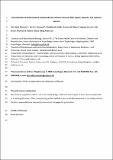Concentration of perfluorinated compounds and cotinine in human foetal organs, placenta, and maternal plasma
Abstract
Background: Perfluoroalkyl substances (PFASs) are bio-accumulative pollutants, and prenatal exposure to PFASs is believed to impact human foetal development and may have long-term adverse health effects later in life. Additionally, maternal cigarette smoking may be associated with PFAS levels. Foetal exposure has previously been estimated from umbilical cord plasma, but the actual concentration in foetal organs has never been measured. Objectives: The concentrations of 5 PFASs and cotinine – the primary metabolite of nicotine – were measured in human foetuses, placentas, and maternal plasma to evaluate to what extent these compounds were transferred from mother to foetus and to determine if the PFAS concentrations were associated with maternal cigarette smoking. Methods: Thirty-nine Danish women who underwent legal termination of pregnancy before gestational week 12 were included; 24 maternal blood samples were obtained together with 34 placental samples and 108 foetal organs. PFASs and cotinine were assayed by liquid chromatography/triple quadrupole mass spectrometry. Results: In foetal organs, the average concentrations of perfluorooctanesulphonic acid (PFOS), perfluorooctanoic acid (PFOA), perfluorononanoic acid (PFNA), perfluoroundecanoic acid (PFUnDa), and perfluorodecanoic acid (PFDA) were 0.6 ng/g, 0.2 ng/g, 0.1 ng/g, 0.1 ng/g, and 0.1 ng/g, respectively. A significant positive correlation was found between the exposure duration, defined as foetal age, and foetal to maternal ratio for all five PFASs and cotinine. Smokers presented 99 ng/g cotinine in plasma, 108 ng/g in placenta, and 61 ng/g in foetal organs. No correlation between the maternal cotinine concentrations and PFAS concentrations was found. Conclusions: PFASs were transferred from mother to foetus, however, with different efficiencies. The concentrations of PFOS, PFOA, PFNA, PFUnDA, and PFDA in foetal organs were much lower than the maternal concentrations. Furthermore, a significant correlation between the exposure duration and all of the evaluated PFASs was found. The health-compromising concentrations of these substances during foetal development are unknown.
Citation
Mamsen , L S , Jönsson , B A G , Lindh , C H , Olesen , R H , Larsen , A , Ernst , E , Kelsey , T W & Andersen , C Y 2017 , ' Concentration of perfluorinated compounds and cotinine in human foetal organs, placenta, and maternal plasma ' , Science of the Total Environment , vol. 596-597 , pp. 97-105 . https://doi.org/10.1016/j.scitotenv.2017.04.058
Publication
Science of the Total Environment
Status
Peer reviewed
ISSN
0048-9697Type
Journal article
Description
We thank The Research Pools of Rigshospitalet and the EU Interregional Project ReproUnion for funding this study.Collections
Items in the St Andrews Research Repository are protected by copyright, with all rights reserved, unless otherwise indicated.

